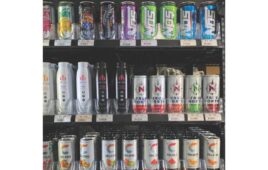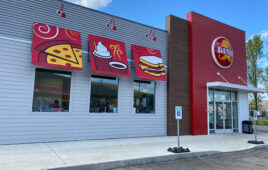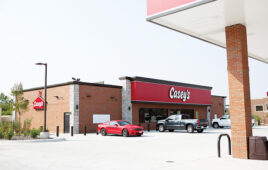 Alcoholic beverages from wine and beer to hard seltzer and ready-to-drink (RTD) cocktails sold well to millions of Americans during the early days of the COVID-19 pandemic, when restaurants and bars across the country closed and customers flocked to their local c-store to stock up on libations to wait out social distancing orders.
Alcoholic beverages from wine and beer to hard seltzer and ready-to-drink (RTD) cocktails sold well to millions of Americans during the early days of the COVID-19 pandemic, when restaurants and bars across the country closed and customers flocked to their local c-store to stock up on libations to wait out social distancing orders.
Now that life is returning to normal for many Americans, convenience store operators are stepping up their merchandising strategies to maintain that volume growth in the alcoholic beverage category in the months ahead. Given the growth in dollar sales across alcoholic beverage sales this year, the rewards for doing so could be vast.
By the Numbers
Some 35% of U.S. adults drink alcoholic beverages regularly, while 27% partake “occasionally” and 12% consume them only when socializing, according to analytics and consulting company GlobalData’s latest Q3 2021 survey.
“This reveals a substantial consumer base for alcohol companies,” said Carmen Bryan, consumer analyst for GlobalData, “as well as for accompaniments such as mixers or snacks — products convenience stores are very well suited to cash in on.”
What are customers buying the most? According to NielsenIQ Spokesperson Madeline Burbach, Total U.S. alcoholic beverage dollar sales in the convenience channel for the 52 weeks ending Sept. 11, 2021, broke down this way:
Total spirits notched more than $2.9 billion, a 17.3% increase over 2020. Whiskey accounted for just over $1 billion, up 16.8%. Scotch sales were slightly over $32 million, up 26.0%. Sales of tequila came in at more than $218 million, a 38.0% rise.
Beer sales reached $19 billion, declining -0.7%, while Beer, Flavored Malt Beverage and Cider sales combined reached nearly $23 billion, increasing 2.2%. Wine sales totaled nearly $1.5 billion, up 7.4%.
Hard seltzer sales surpassed $1.7 billion, a 44.9% jump. Hard tea sales were more than $476 million, a 27.5% rise. Hard kombucha sales reached over $6.5 million, a 92.9% jump. Sales of hard coffee topped $11 million, a 33.5% increase.
“Because the nature of convenience stores leverages an impulse-buy mentality, it’s important for stores to stock well-known, familiar brands that consumers can trust,” Bryan said. “Striking visuals and packaging designs are also vital to create a shelf presence and catch consumers’ eyes.”
Over the past 12 months, the popularity of fruity and sweet beers has been growing at c-stores, especially among the major chains that have developed their own proprietary brands of beer in the past few years, said Mark Brandau, group manager for market research firm Datassential.
“It looks like Sheetz is a particularly strong performer in this trend,” he said. “Its I Scream, Brew Scream Milkshake IPA (created in partnership with Chicago-based Goose Island Beer Co.) tested as a top performer against all other alcoholic beverages, even those offered at restaurants, for consumers’ ratings of its uniqueness and draw. Wawa took a similar approach (in partnership with Aston, Pa.-based 2SP Brewing Co.) with its Sunfest Strawberry Lemonade Shandy, introduced this past June.”
Spirits-Centric Concept
In late July, veteran St. Louis c-store operator Amer Hawatmeh, who divested his 52 Coast to Coast c-stores and recently moved operations to California and introduced his first Coast to Coast Bodega in Santa Clarita. He plans to open another three convenience stores by the end of the year, with further expansion set for 2022.
His new concept places a heavy emphasis on beer, wine and spirits, which are projected to account for more than 70% of sales in the stores, while still stocking traditional c-store items. He calls it a hybrid convenience store/liquor store.
“The premium beer section, including craft beers, is huge,” Hawatmeh noted, citing the growing demand for IPAs and other craft beer varieties. The other subcategory growing quickly is made up of alcoholic seltzers, teas and waters, he said.
“Devo, an alcoholic coconut water, is one of my top sellers. That’s kind of the new trend there,” he said. On the liquor side, sales of tequilas and bourbons are surging.
Coast to Coast’s merchandising plan includes a large display of Barefoot Wine by the entrance. “We do ‘two for $9.99,’ so the immediate perception is that there is value in the store,” Hawatmeh said.
Hawatmeh is hopeful the increased sales the adult beverage category experienced in 2020 and 2021 due to COVID-19 will continue into 2022. And he has reason to be optimistic. The alcoholic beverage market in the U.S. is expected to grow by $64.01 billion between 2020-2024, expanding at a compound annual growth rate (CAGR) of nearly 5%, per Technavio, a global technology research and advisory company.
Hawatmeh advised other retailers to consider an expanded adult beverage offering, given the opportunity in the category.




